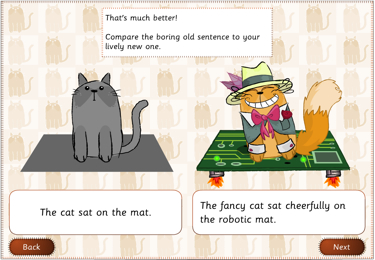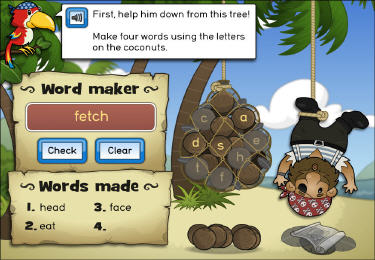Variety
PIN number: IHCAAC
-


L8740 Wonderful words, creative stories: pets
- Published 18/10/2016
- TLF-ID L8740
Add descriptive words to two simple sentences about a cat and a fish to make the sentences more interesting. Substitute different descriptive words in each sentence. Notice how your choice of words affects the animations for the sentences. Use your two lively sentences as the start and ending of an imaginative story. Check your word choices to see if the story could flow better. Then complete the following extension activities: describe a pet-related image; use a new set of words to create another vivid sentence; extend your story about pets.
View resource -


L9479 Procedural texts: let's plant a tree
- Published 16/05/2017
- TLF-ID L9479
Explore the three steps in a procedure; aim, materials and steps by looking at four examples. Discover the steps to plant a tree. Find the materials you'll need for planting the tree hidden in a classroom. Investigate the steps to plant the tree by taking photos. Put the jumbled steps of the procedure in the right order. This learning object is one in a series of five objects.
View resource -


L8304 Pirate treasure hunt: eight challenges
- Published 27/09/2016
- TLF-ID L8304
Join forces with Pirate Jack. He needs your help to solve eight problems and find the hidden treasure. Use the map to work your way through the obstacles one by one and in the right order. Apply your maths and literacy skills to make sure you collect the correct item before tackling the next obstacle. For example, you’ll need to order a set of words from coldest to hottest to find a lantern before you can explore a dark cave. Use different strategies to solve the clues, and you’ll find the booty.
View resource -
![Create a soil environment [no spoken instructions]](/ec/viewing/L188/support_files/thumb.jpg?useDefault)

L188 Create a soil environment [no spoken instructions]
- Published 10/04/2020
- TLF-ID L188
Grow flowers or vegetables in a garden bed. Compare results when adding things such as water, organic matter, digging tools and earthworms.
View resource -


L30 What on Earth?
- Published 10/04/2020
- TLF-ID L30
Help an alien to understand how flowering plants are adapted to living on Earth. Watch a demonstration about plant functions such as photosynthesis. Then examine plant parts to see how they work. This learning object is the first in a series of two objects titled 'Plant life'.
View resource -


L1360 Life cycles: flowers
- Published 24/04/2017
- TLF-ID L1360
Look at the development of a waratah flower from a tight bud, the bud opening up to a full flower, and finally, the flower wilting. Grow some flowers and take daily notes on their development. Record changes in a calendar. This learning object is one in a series of six objects. The series is also packaged as a combined learning object.
View resource -


L1036 Job match: choose the characters
- Published 10/04/2020
- TLF-ID L1036
Meet a range of people gathered at community scenes. Select people best suited to cook for a party, put out a house fire, provide medical care and resdesign a damaged house. Choose people according to their abilities, not their appearances. Gather information to make good decisions. In most of these situations, only one person is suited to each task. This learning object is one in a series of three learning objects.
View resource -


L1798 Water matters: watering the garden
- Published 10/04/2020
- TLF-ID L1798
Compare the amount of water used when watering a garden with equipment such as a hose or a sprinkler system. Choose how often to water the garden. Look at the results of using mulch on garden beds. Use a graph to compare the efficiency of water use options. This learning object is one in a series of six objects.
View resource -


L32 Why recycle?
- Published 10/04/2020
- TLF-ID L32
Meet a group of children eating their lunch at school. Notice how each child uses or disposes of their plastic lunch bag in a different way. Predict where the bags might end up and how they may affect the environment. Find out about the durability of plastics and environmental benefits of recycling.
View resource -


L903 Buds: level 2
- Published 10/04/2020
- TLF-ID L903
Help a farmer to win an award for business innovation. Start out by farming fresh flowers and selling them. Think creatively to find new market opportunities and meet demand. Decide when to use equipment to make different products such as compost and pressed flowers. This activity is a medium level of complexity in a series of four activities.
View resource -


L9512 Discovering democracy: joining in
- Published 26/04/2021
- TLF-ID L9512
View a slideshow of images and text to find out about volunteer groups and people who contribute to the Australian community such as Clean Up Australia and Meals on Wheels. Complete a related task.
View resource
